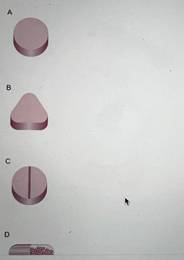Which oral medication can the nurse safely cut in half?

A
B
C
D
The Correct Answer is C
A. This tablet has no score line and could have an extended-release or special coating that should not be altered. Cutting it may affect absorption and safety.
B. The triangular shape and lack of score line suggest it is not intended to be split, risking improper dosing or altered release.
C. The tablet in option C has a scored line (a groove down the middle), which indicates that it can be safely split. Scored tablets are manufactured to ensure even distribution of the active ingredient, making it safe for dose division.
D. This is a capsule, which should never be cut or opened unless specifically directed, as it may contain extended-release beads or irritants.
Nursing Test Bank
Naxlex Comprehensive Predictor Exams
Related Questions
Correct Answer is A
Explanation
A. Hydrocortisone: Addison’s disease is characterized by insufficient cortisol production. The client’s symptoms, including weakness, confusion, and dehydration, along with laboratory values indicating low sodium, low glucose, and elevated potassium, suggest an adrenal crisis. Hydrocortisone is the primary.
B. Regular insulin: Regular insulin is used to lower blood glucose levels, but the client’s glucose level is already low, not high. Insulin could worsen the client's hypoglycemia. The focus should be on correcting the cortisol deficiency rather than administering insulin.
C. Broad spectrum antibiotic: While antibiotics may be needed if there’s a concern for infection, there’s no evidence of active infection here. The priority is addressing the client's Addisonian crisis, which is primarily treated with hydrocortisone, not antibiotics.
D. Potassium chloride: The client's potassium is elevated (5.3 mEq/L), but potassium chloride is not indicated in this case. The priority is to manage the underlying adrenal crisis, which will address the electrolyte imbalance.
Correct Answer is B
Explanation
A. Advise the UAP to document the last blood pressure obtained on the client's graphic sheet: Documenting a previous reading does not reflect the client’s current condition and can be misleading in decision-making. Vital signs should be based on real-time assessment.
B. Demonstrate how to palpate the popliteal pulse with the client supine and the knee flexed: The popliteal site is appropriate for measuring blood pressure when the arms are inaccessible. Flexing the knee while the client is supine allows better access to the artery and enables accurate assessment of blood pressure in this situation.
C. Document why the blood pressure cannot be accurately measured at the present time: While documentation is necessary if no alternative is available, the nurse must first exhaust appropriate options for obtaining a blood pressure before choosing to omit it.
D. Estimate the blood pressure by assessing the pulse volume of the client's radial pulses: Pulse volume gives a very rough estimate of perfusion but does not provide an accurate or objective blood pressure measurement. This method lacks precision.
Whether you are a student looking to ace your exams or a practicing nurse seeking to enhance your expertise , our nursing education contents will empower you with the confidence and competence to make a difference in the lives of patients and become a respected leader in the healthcare field.
Visit Naxlex, invest in your future and unlock endless possibilities with our unparalleled nursing education contents today
Report Wrong Answer on the Current Question
Do you disagree with the answer? If yes, what is your expected answer? Explain.
Kindly be descriptive with the issue you are facing.
